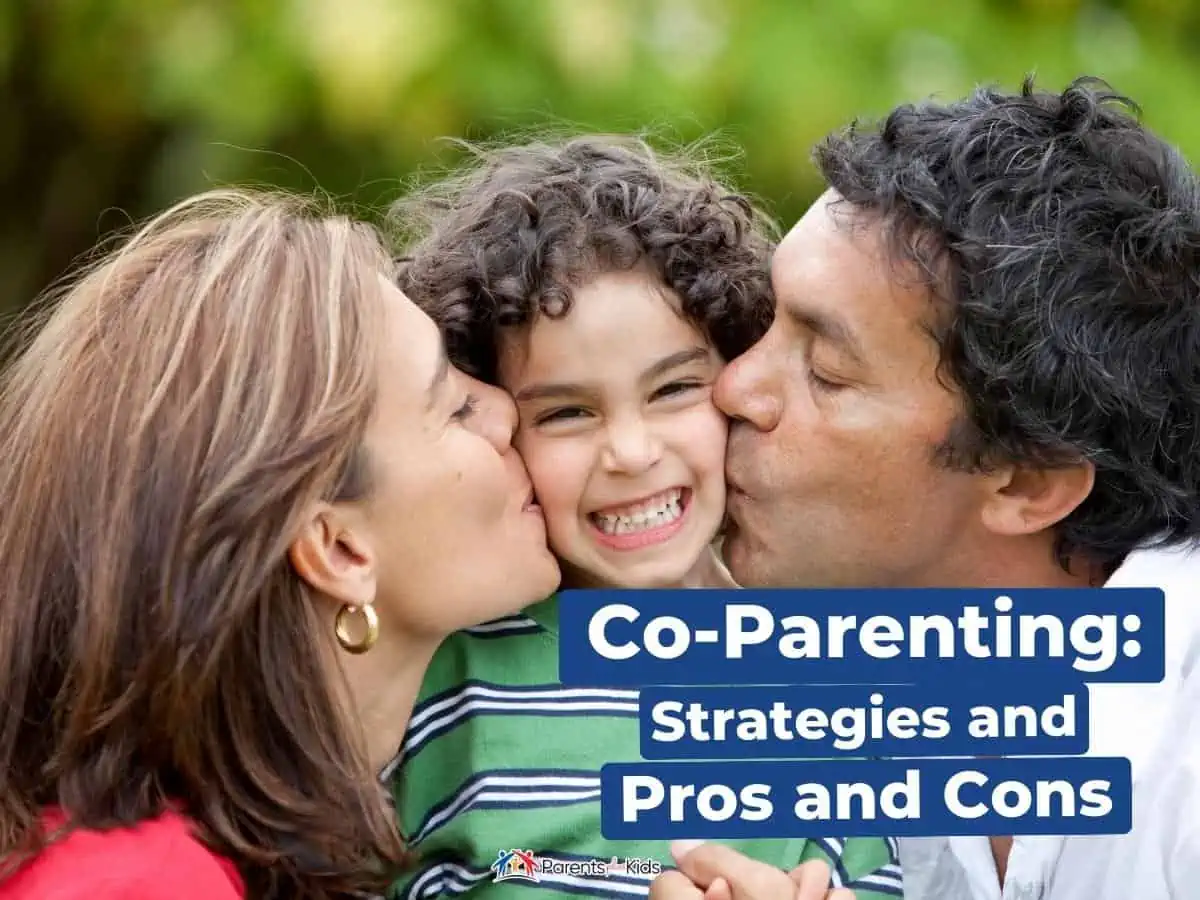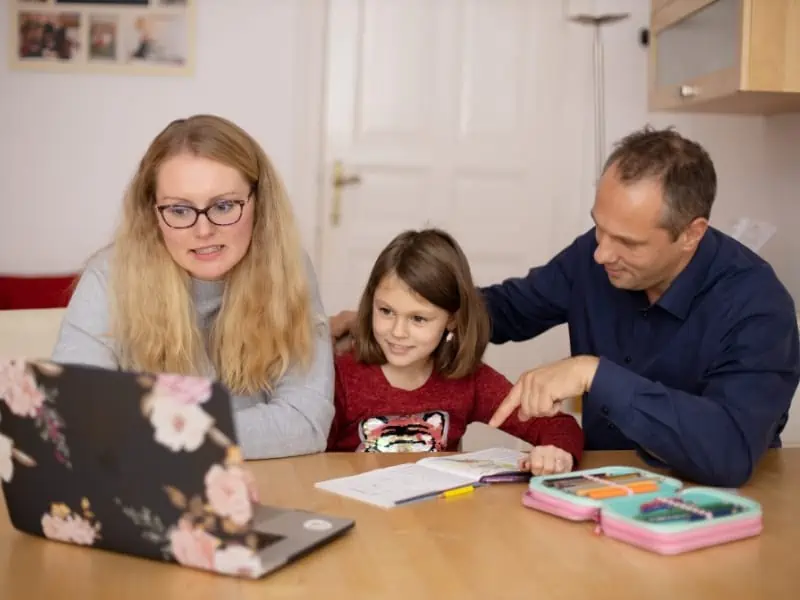Co-Parenting: What is it? Strategies and Pros and Cons

This post may contain affiliate links. If you buy through the link, I may earn a commission. Learn More.
Co-parenting is a complex yet rewarding concept.
It calls for a balance between cooperation, respect, and understanding from both parents, with the ultimate goal being the welfare of their children.
Let’s first take a step back and talk about what co-parenting is before talking about its advantages, potential drawbacks, and the strategies that make it work.
What is Co-Parenting?
Co-parenting is a shared child-rearing arrangement between two separated or divorced parents. It’s about both parents actively participating in their child’s life, ensuring their emotional, physical, and cognitive development.
Co-parenting calls for effective communication, mutual respect, and a lot of patience and compromise.
Tracing the Origins and Progress of Co-Parenting
The concept of co-parenting has evolved significantly over the years, moving away from traditional family structures and embracing more flexible, child-focused approaches.
As our understanding of child psychology and family dynamics has advanced, so has the concept and practice of co-parenting.
Why Does Co-Parenting Matter?
Co-parenting is important for several reasons.
First it helps maintain the child’s bond with both parents, assuring them of the love and care of both their mom and dad.
It also shares the responsibilities of parenting between two people instead of burdening one.
Furthermore, effective co-parenting sets a positive example for children about problem-solving and compromise.
Navigating Co-Parenting
Embarking on the co-parenting journey might seem daunting at first. It involves working closely with a person with whom you may have a complicated past.
The most crucial aspect of navigating co-parenting successfully is setting personal differences aside and placing your child’s interests at the forefront.
This journey requires open communication, patience, and mutual respect. Despite any past grievances, parents need to collaborate on vital aspects like discipline, education, healthcare, and other key elements of child-rearing.
Establishing a structured plan and sticking to it can help create a steady and predictable environment for the child.
Strategies for Effective Co-Parenting

Co-parenting is not without its challenges. However, effective strategies can help make the process smoother and more beneficial for all involved.
Open and respectful communication forms the backbone of successful co-parenting. It’s crucial to keep each other informed about the child’s activities, emotions, achievements, and struggles. You need not agree on all fronts, but it’s necessary to show a united front to the child.
Keeping routines and rules consistent across households is another effective strategy. This uniformity provides the child a sense of security and stability, reducing potential stress or anxiety.
Remember, your child’s needs and emotions should guide your co-parenting strategies. Validate their feelings, encourage them to express their concerns, and assure them that both parents love them unconditionally and are committed to their well-being.
Co-Parenting from the Child’s Perspective
From a child’s perspective, co-parenting can bring mixed emotions.
On the one hand, they get to have a meaningful relationship with both parents, which is incredibly beneficial for their emotional development.
On the other hand, they may struggle with the changes in family dynamics.
Children may express fear, anger, confusion, or sadness during the transition.
It’s important to reassure them, validate their feelings, and encourage open dialogue about their worries and concerns.
Kids in co-parenting setups often enjoy the consistency it offers and the continued involvement of both parents in their lives.
Over time, they adjust to their new normal and appreciate the stability that effective co-parenting can bring.
Co-Parenting in Special Circumstances

Co-parenting doesn’t always fit within the confines of a typical framework. Various circumstances can add extra layers of complexity to the co-parenting equation.
Whether it’s managing co-parenting from a distance, navigating the challenges of co-parenting with a difficult ex-partner, or blending new families.
Understanding how to handle these special circumstances can make a significant difference in your co-parenting journey.
Co-Parenting from a Distance
The geographic distance can pose a significant challenge to co-parenting.
This might occur if one parent needs to relocate for work or personal reasons, turning your co-parenting into a long-distance endeavor.
But fret not!
With the right strategies and a positive attitude, you can ensure your child feels supported and loved, no matter the miles that separate you.
The key to long-distance co-parenting lies in clear, consistent communication.
It’s essential to keep each other updated about the child’s day-to-day life, including school updates, health matters, and emotional well-being.
Thankfully, technology has made this much easier – regular video calls, sharing photos, or just a quick text can keep the non-residential parent involved and informed.
Also, plan visits and vacations so the non-residential parent can spend quality time with the child.
Ensure that the child understands the situation and knows that the distance doesn’t diminish the love or commitment of their non-residential parent.
Co-Parenting with a Challenging Ex
Sometimes, co-parenting becomes particularly hard when you’re dealing with a difficult ex-partner.
This situation might bring an added layer of stress and strain to the co-parenting arrangement, but there are ways to navigate these choppy waters effectively.
First and foremost, establish firm boundaries about what is acceptable behavior.
This could be about communication norms, the time spent discussing issues, or rules about dropping off and picking up the children.
Keep communication focused on the child and avoid getting dragged into personal disputes or past arguments.
If face-to-face interactions are too heated, consider using written communication via emails or texts.
These methods provide a record of communication, ensure clarity, and might even encourage more respectful exchanges.
Lastly, seek emotional support. This could be from a professional counselor, supportive friends, or support groups for co-parents.
Remember, the primary aim is to foster a healthy environment for your child, so taking steps to manage stress and maintain your own emotional health is crucial.
Co-Parenting in Blended Families
Co-parenting can get complicated when new partners, step-siblings, or even new babies enter the family dynamic.
Adjusting to these changes while maintaining a functional co-parenting arrangement can be a delicate balancing act.
Open communication with everyone involved is essential here.
Discuss the changes with your child and reassure them about their place and importance in the restructured family.
Talk to your ex-partner about the new dynamics and how you can work together to keep things stable for your child.
It’s important to also involve the new partners in the co-parenting plan, ensuring they understand their role and the importance of maintaining harmony for the child’s sake.
Patience, understanding, and respect will be key here – it’s a new situation for everyone involved and may take some time for things to settle.
Remember, co-parenting in special circumstances might require some extra work, but it’s all in service of providing the best possible environment for your child.
Stay patient, flexible, and focused on what’s truly important – your child’s well-being.
Pros and Cons of Co-Parenting
Like any other parenting style, co-parenting has its pros and cons.
Pros of Co-Parenting
Co-parenting ensures that the child maintains a close relationship with both parents, which contributes to their emotional stability and sense of security.
It encourages parents to work together as a team, promoting a spirit of cooperation and mutual respect.
It provides children with a consistent set of expectations and rules, which fosters a balanced upbringing.
Cons of Co-Parenting
Co-parenting might be challenging when parents have a contentious relationship or have differing parenting styles and values.
It might be emotionally taxing for the parents to set aside their differences and work collaboratively.
Moreover, co-parenting might not be the best choice in cases where there’s a history of abuse or neglect, as the child’s safety and well-being must be the top priority.
In the end, the success of co-parenting depends on the parent’s ability to communicate effectively, cooperate, and prioritize their child’s well-being over personal disagreements.
Despite the challenges, when done right, co-parenting can provide a nurturing and balanced environment for children to grow and thrive.
Key Takeaways
Co-parenting isn’t easy, but it’s a journey worth taking.
The rewards it brings for your child’s growth, happiness, and your own personal development are priceless.
Related Articles
- Ways to Get Poop Smell Off Your Hands
- Pros and Cons of Having Just 1 Child
- Why You Should Not Take Parenting Classes
- Should Parents Earn Respect From Their Kids?
- The Pros and Cons of Having Kids
